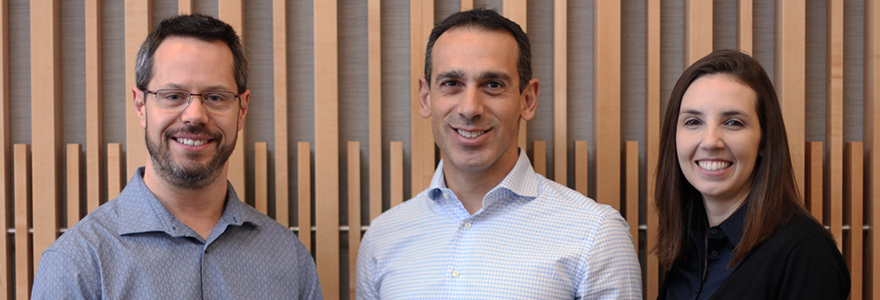Training the 21st Century Scientist
 Graduate programs are rethinking the traditional training model, focusing on comprehensive and transferable skills that cross disciplinary boundaries
Graduate programs are rethinking the traditional training model, focusing on comprehensive and transferable skills that cross disciplinary boundaries
By Emily Leighton, MA'13
Sarah Mattonen’s imaging research lab is three floors above a regional cancer clinic that sees 185,000 patient visits each year.
“To succeed in their next career steps and have real impact, trainees need to learn to place their innovations within a social context. This means the development of robust communication and leadership skills to effectively disseminate their innovations.” — Aaron Ward, PhD
In this busy space, Mattonen, PhD’16, Assistant Professor, collaborates with clinicians and basic scientists across multiple disciplines to develop, evaluate and translate imaging analysis tools. Her work supports clinical decision-making to enhance cancer diagnosis and treatment.
She is a 21st century scientist.
“The translational aspect of my work and the impact it can have on clinical care, is why I pursued a career in research,” said Mattonen, who also holds the inaugural Gerald C. Baines Chair in Translational Cancer Imaging.
How do we train the next generation to be 21st century scientists like Mattonen – to help solve the messy, complex problems that threaten human health and the planet?
It’s a challenge for graduate programs that focus on building hyper-specialized knowledge and skills. “In the real-world context, problems do not cleanly categorize within specific academic disciplines,” explained Aaron Ward, PhD, Professor and former Graduate Chair for Medical Biophysics.
But graduate programs are also uniquely positioned to deliver the comprehensive training needed to help trainees navigate the current landscape.
Ward says programs must consider how they can equip trainees with advanced problem-solving skills across multiple disciplines. “Graduate training outcomes must be broader than the undertaking of a successful research project,” he said. “The ability for trainees to work and communicate across disciplinary boundaries will set them apart.”
In Medical Biophysics, outcomes are organized along three dimensions: innovation, communication and leadership. By participating in novel, multidisciplinary research that addresses existing health care problems, trainees learn to develop innovative study designs, techniques and technologies.
The program emphasizes key transferable skills, directly teaching trainees to communicate their ideas to more general science audiences, as well as members of the community.
“I work with trainees on identifying goals and how I can best get them to where they want to go.” — Sarah Mattonen, PhD’16
“To succeed in their next career steps and have real impact, trainees need to learn to place their innovations within a social context,” said Ward. “This means the development of robust communication and leadership skills to effectively disseminate their innovations.”
Where this training occurs is another important consideration. As a clinician-scientist, Dr. David Palma, Professor in Oncology, understands the value of physical proximity between basic medical scientists and clinical collaborators. “In the biomedical field, the clinical perspective is a big advantage,” he said. “The co-location of basic scientists and clinicians can spark ideas and lead to novel research projects.”
At Schulich Medicine & Dentistry, many trainees work in labs within its academic teaching hospitals and Robarts Research Institute.
Dr. Palma points to multidisciplinary cancer conferences, or ‘tumour boards’, as an opportunity for collaboration. These regularly scheduled meetings bring together health care providers from a variety of medical specialties to discuss diagnosis and treatment options for individual cancer patients. “Graduate trainees can attend and hear from surgeons, radiologists, pathologists and radiation oncologists discussing the controversies and uncertainties,” he explained. “They can be a fly on the wall, listen and gain insight on the clinical perspectives.”
“In the biomedical field, the clinical perspective is a big advantage. The co-location of basic scientists and clinicians can spark ideas and lead to novel research projects.” — Dr. David Palma
With less than 15 per cent of trainees obtaining traditional academic appointments after graduation, programs are also rethinking career planning and shifting focus to careers in industry, public policy or entrepreneurial pursuits.
Ward says it starts with looking beyond the stereotype of the scientist as an academic and scholar. “We need to dispense with any notions that non-academic career paths are somehow ‘less than’,” he said.
To support career planning, programs are tapping into alumni who have built successful careers outside the ivory tower. In Medical Biophysics, for example, an alumni seminar series provides trainees with different points of view and an opportunity to connect and ask questions from people pursuing non-traditional career paths.
Completing her first year as an independent investigator, Mattonen views graduate training as a cornerstone of her research program. “My trainees are my number one priority,” she said. “And they help me build and evolve the culture and supportive training experience they want to see.”
Mattonen says asking for consistent feedback about what’s valuable and what works or doesn’t work also helps her tailor the experience for individual trainees. “I work with trainees on identifying goals and how I can best get them to where they want to go.”
The 21st century scientist will not be defined by their expertise in a single subject matter, but rather, as an expert in the process of acquiring knowledge and the transferable skills that accompany it – critical thinking, creativity, observation and communication to name a few. “As supervisors, we need to challenge trainees, as well as ourselves, to take a step back and look at the bigger picture,” said Mattonen.









